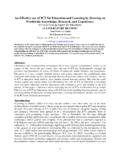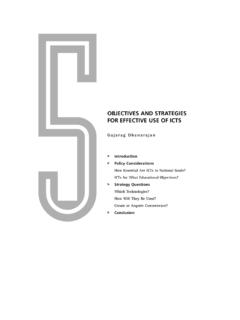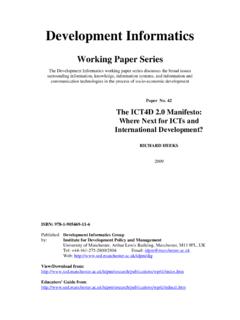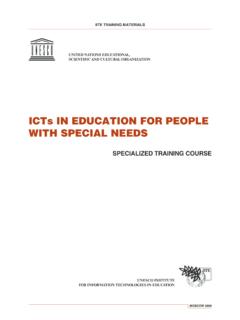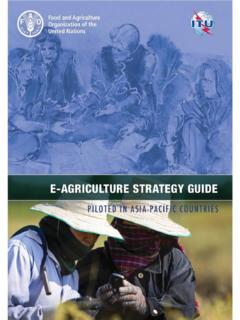Transcription of ICTs and development in Zambia: challenges and …
1 Information and communication technologies ( icts ) are increasingly important in achieving development goals and promoting citizen participation. zambia is one of a number of countries in the Southern African region that have sought to include icts in their national development plans. This policy brief summarises a review of the successes and failures of this approach in zambia , and considers the next steps that are needed to meet the information and communication needs of the coming dialogue, debate and change Policy briefingICTs and development in zambia : challenges and opportunities This brief summarises a review of zambia s ICT4D experience, Contextualising Information and Communication Technology for development (ICT4D) in zambia .
2 The review was conducted by JSM Business Consultants as part of the Thetha Regional ICT Discussion Forum Project, coordinated by SANGONeT and funded by the Open Society Initiative for Southern Africa and the Embassy of Finland in South Africa. The Thetha Project aims to provide a body of experience and framework for discussion of future ICT policy in the Southern Africa region. The full report can be seen at This is one of a number of policy briefs produced by Panos London based on the work of the Thetha project: icts have received growing attention in recent years from development practitioners, policymakers, government officials and civil society organisations in Southern Africa.
3 They are believed to contribute to improving development outcomes in two main ways: p ICT-based knowledge and products contribute directly to wealth creation p the use of icts contributes indirectly to national development through its impact in social and economic sectors such as agriculture, health and education, and by empowering individuals to take advantage of new opportunities. Individuals also benefit from the availability and use of icts in a number of ways for example, by substituting phone calls for travel, which saves time and money, and by using icts to obtain information on prices, for their own produce and for purchases.
4 In these various ways, icts can have a significant impact on a country s ability to achieve the Millennium development Goals (MDGs). There are, however, also constraints on the potential impact of icts in many developing countries. These constraints include inadequate technical infrastructure, limited human skills to use available networks and services, the relatively high cost of communications equipment, and poor policy and regulatory environments. These factors reduce the scope for countries and communities to realise the potential of icts for development (ICT4D), and may even increase exclusion and marginalisation.
5 The difference between access to and use of icts in urban and rural areas, and between prosperous and poor members of society often called the digital divide has been of particular concern. Technician setting up satellite receiver for Macha Works. macha works The limited fixed phone network has proved to be a major constraint on internet access in zambia . In 2007, the Communications Authority of zambia (CAZ) estimated that there were 18,000 internet subscribers in the country, mostly using dial-up access. Even in 2009 some government departments were still using dial-up rather than broadband internet connections.
6 However, thanks to rapid growth in the number of telecentres and cybercaf s, the number of internet users is estimated to have risen from around 50,000 to 500,000 between 2006 and 2007. These telecentres are managed either by private entrepreneurs or by NGOs, some with donor support. There is no official initiative to promote them, but potential telecentre operators may borrow from state empowerment funds to cover set-up costs. Telecentres have become the most important means of access for internet users in zambia , although as elsewhere in Africa it has been difficult to establish successful business models or to ensure skilled maintenance of technical equipment.
7 The Republic of zambia is a landlocked country in Southern Africa, which has been independent since 1964. Its population has grown from million in 2000 to million in 2008. zambia ranks 164th out of 182 countries in the Human development Index as listed in the UN Human development Report 2009. This puts it in the category of countries with low human development . The country s economy is towards the lower end of the sub-Saharan African spectrum, with a GNP per capita of US$1,300, although growth rates averaged more than 5 per cent in the years leading up to the 2007 2008 international financial crisis.
8 The economy is highly dependent on agriculture and on the extraction of copper from an area of the country known as the Copperbelt. As a least-developed country, zambia suffers from high levels of deprivation and poor infrastructure, especially in rural areas. Literacy, however, now runs at between 85 per cent and 90 per cent of the adult population. The country s current National development Plan covers the years 2008 2012. Priorities for national development include education, agriculture (food security), wealth creation and the reduction of HIV and AIDS and malaria. icts in zambia Like other countries in sub-Saharan Africa, zambia has experienced a tremendous upsurge in telephone ownership and use since the advent of mobile phones.
9 The number of mobile phone subscriptions rose from less than 500,000 in 2003 to more than 3 million in 2008, around one cellphone for every two adult citizens. At least one of zambia s mobile networks now has coverage throughout the national territory. The fixed telephone network, however, remains extremely limited in range and use largely confined to the main urban centres, the Copperbelt and the rail links between them. In 2008 there were just over 90,000 fixed line subscriptions. While the mobile and internet sectors are competitive there are three national mobile operators and some 20 internet service providers (ISPs) the fixed network has remained a monopoly of the state-owned company ZAMTEL.
10 ZAMTEL also has monopoly rights over the country s international gateway which allows phone connectivity to other countries. icts and development in zambia : challenges and opportunities2 The Zambian context Research methodology The study used three working methods: desk research into statistics, reports and policy development resources; interviews with some 40 stakeholders in a variety of social and economic sectors, including the ICT sector itself; and online consultation on issues such as the progress of the 2009 ICT Act. The Zambian economy is heavily reliant on copper mining.
